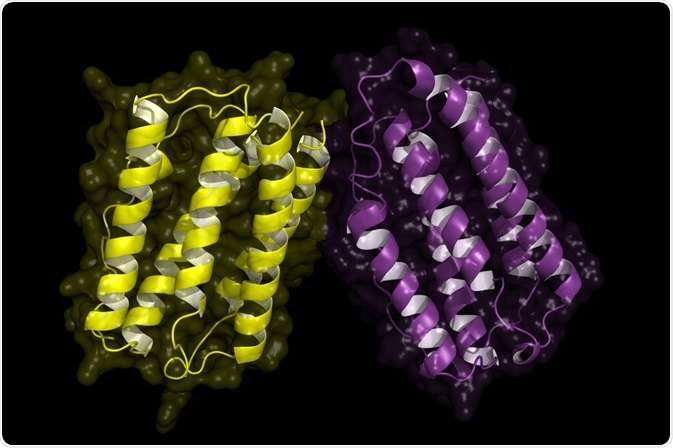The study of cell surface proteomics has led to a growth in knowledge of how this family of proteins function, what their structure is like, what modifications they undergo before and after translation, and more. This information is critical to the formation of disease, such as cancer.
 Image Credits: petarg / Shutterstock.com
Image Credits: petarg / Shutterstock.com
Recent studies have begun to show that the cancer cell surface proteome can be used as a marker of disease, and help to establish new, more targeted therapies with the potential of reducing side effects and being more effective.
The identification of novel therapeutic targets in cancer
Studies into cell-surface proteomics are making a big impact on cancer research. Currently, while advancements have been made in cancer treatment over the decades, there remains the issue that standard therapies are not targeted enough.
Modern chemotherapy is toxic to all dividing cells, not only to cancerous ones. Healthy body tissues that are characteristically growing and dividing, such as hair, bone marrow, skin, and the digestive system, are affected by chemotherapy, causing detrimental side effects.
Research has shown that more targeted, less toxic therapies have assisted in boosting survival rates in various cancers. For this reason, there has been a focus on developing new therapies with the capabilities of being more accurate at delivering the harmful effects of treatment to only the cancerous cells, reducing unwanted side effects, enhancing patients’ q quality of life while undergoing treatment, and improving remission rates.
One such method that is being developed is using cell surface proteins as a target for therapy. These proteins provide a convenient target for treatments because their engagement in essential signaling pathways is often abnormal in cancer, which helps to locate the cells that the therapy seeks to destroy, and they are also in an easily-accessible location (the outer surface of the cell), which aids treatment effectiveness.
Until recently, studies that have explored the use of cell-surface proteins as a therapeutic target for cancer have been limited due to the fact that their poor solubility and relatively low expression levels have made investigations challenging. Given that studying intracellular proteins does not carry these same drawbacks, proteome research has focused on these proteins rather than on cell surface proteins.
However, new studies are elucidating just how beneficial the cell surface proteome can be in establishing new therapeutic targets. Below, research that has revealed the therapeutic potential of targeting cell surface proteins is discussed in relation to two kinds of cancer, glioblastoma and leukemia.
Markers of glioblastoma
In 2017, a team of researchers in the US uncovered the molecular signature for glioblastoma (GBM) by integrating cell-surface proteomics and transcriptomics from patients' tumors. Using this method, they were able to identify the 33 cell surface transmembrane proteins that make up the signature for GBM.
In identifying the cell surface proteins involved in GBM, they were able to understand more about the nature of the disease. They found that 17 of the 33 proteins in the signature were related to transforming growth factor-beta signaling pathways.
In addition, the team was able to select a subset of four proteins, CD44, VCAM1, HMOX1, and BIGH3, which they found to be significantly overexpressed in GBM patients in comparison to healthy controls. This evidence suggests the potential of these four proteins as clinical biomarkers of GBM, which could have applications as therapeutic targets.
Potential therapeutic targets of chronic lymphocytic leukemia
A research team in the UK recognized that while chronic lymphocytic leukemia (CLL) is the most common form in both North America and Europe, a cure for the disease has remained elusive, with modern chemotherapy failing to provide an antidote.
With this in mind, the British team looked to cell surface proteins to provide a potential target for more effective therapy. They looked into the proteins that are expressed at cell surface membranes in patients suffering from CLL. Using a plasma-membrane-based proteomic analysis they were able to determine that two novel proteins of BCNP1 and MIG2B could provide the key they were looking for.
Since this study was conducted many have followed in its path to be successful in identifying potential therapeutic targets for not only CLL but for other kinds of cancer, such as prostate cancer and ovarian cancers.
Future therapeutic potential
Researchers continue their efforts to advance treatment options for cancer by investigating the cell surface proteome in cancer in order to identify proteins that could act as therapeutic targets. The evidence is suggesting that the outcome of the research is likely to improve the sensitivity, efficiency, and effectiveness of cancer treatments, and may potentially provide a method of attacking cancers that show resistance to chemotherapy.
Currently, the work is helping to aid the selection of relevant targets for the development of future therapies. It could be years before these therapies become available, due to the long and thorough clinical trial period required to ensure the safety of new methods.
Sources:
- Boyd, R., Adam, P., Patel, S., Loader, J., Berry, J., Redpath, N., Poyser, H., Fletcher, G., Burgess, N., Stamps, A., Hudson, L., Smith, P., Griffiths, M., Willis, T., Karran, E., Oscier, D., Catovsky, D., Terrett, J. and Dyer, M. (2003). Proteomic analysis of the cell-surface membrane in chronic lymphocytic leukemia: identification of two novel proteins, BCNP1 and MIG2B. Leukemia, 17(8), pp.1605-1612. https://www.nature.com/articles/2402993.pdf?origin=ppub
- Ghosh, D., Funk, C., Caballero, J., Shah, N., Rouleau, K., Earls, J., Soroceanu, L., Foltz, G., Cobbs, C., Price, N. and Hood, L. (2017). A Cell-Surface Membrane Protein Signature for Glioblastoma. Cell Systems, 4(5), pp.516-529.e7. https://www.cell.com/cell-systems/pdf/S2405-4712(17)30089-3.pdf
- Kuhlmann, L., Cummins, E., Samudio, I. and Kislinger, T. (2018). Cell-surface proteomics for the identification of novel therapeutic targets in cancer. Expert Review of Proteomics, 15(3), pp.259-275. https://www.ncbi.nlm.nih.gov/pubmed/29343144
Further Reading